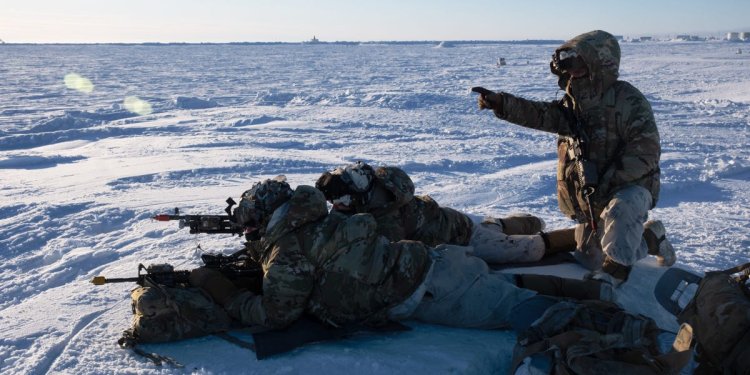US soldiers are fighting to get back lost skills for war in the 'most challenging environment on the planet,' Army general says
At a training event in Alaska, the Army challenged soldiers to be a cold-weather fighting force ready for future conflict.

U.S. Army Photo by Pfc. Brandon Vasquez
- The US Army's new JPMRC training rotation in Alaska prepares soldiers to fight in frigid conditions.
- Readiness in the Arctic environment is a renewed priority for the Army.
- Many skills related to Arctic combat had atrophied, generals said.
Out on the Alaskan tundra, the US Army is pushing soldiers to their limits and recovering lost skills needed to fight in the sub-zero temperatures and ever-changing conditions of the Arctic.
The ability to fight in this part of the world, which a commanding general called "the most challenging environment on the planet," is a renewed priority for the Army after many years of shifting focuses caused readiness for Arctic combat to atrophy.
In February, USARPAC led the third annual Joint Pacific Multinational Readiness Center training near Fairbanks, Alaska, which Business Insider was able to observe. Throughout the training, soldiers with the US Army's 11th Airborne Division and troops from over a dozen international allies and partners drilled in Arctic warfare, running combat scenarios while adapting their essential gear, kit, and equipment to freezing conditions.
The training, carried out in what many described as the harshest part of winter in Alaska, pushed more than 8,000 troops to challenge themselves, Army leaders said, innovate in an unpredictable environment, and learn how to fight, survive, and thrive. It comes at a time when the US military has identified readiness to fight in the Arctic, and the Pacific region more broadly, as vital for the American military. U.S. Army photo by Pfc. Elijah Magaña
For the last 20 years, Maj. Gen. Brian S. Eifler told Business Insider during the training, "we were focused on Iraq, Afghanistan, and really the forces up here, really two maneuver brigades developed up here because of that, were not here for anything other than deploying from and getting to Iraq and Afghanistan."
During the Cold War, the Army's forces in Alaska were focusing on cold weather combat, but JPMRC demonstrates a new and unprecedented investment. Troops told BI they felt like they were writing history with these exercises, doing something not seen across other divisions in the Army and US military.
Army leaders conduct the JPMRC training in the middle of winter, when conditions can be especially rough. On the flip side, JPMRC also does an annual rotation in Hawaii, training soldiers to fight in the wet, humid jungle.
USARPAC leaders have identified these environments as the ones in the Indo-Pacific region Army forces need to be able to effectively fight in. Last fall, USARPAC commander Gen. Charles Flynn said the vast Pacific was "likely to remain the geostrategic center of gravity well into the 21st century."
Regional tensions require preparedness. Flynn noted that aggression, particularly from China, was reinforcing a focus on both maintaining readiness and deterring potential conflict in the area. U.S. Army Photo by Pfc. Brandon Vasquez
To do that, specifically in the Arctic, the Army reorganized its forces in Alaska back in 2022. US Army Alaska officially became the 11th Airborne Division, a newly reactivated unit, with the focus on Pacific and Arctic combat.
"Our mission is to deter the threats and be ready to fight and win both in the Indo-Pacific and the Arctic," Eifler said at the time. "And yes, that's a unique and difficult mission." The general told reporters US Army Alaska had "sort of lost the Arctic ethos" because of its focus on counterinsurgency in the Middle East.
"We were a brigade, and we had an airborne battalion, then it was going away," he said. "Then we had the Strykers. Then [we were] deploying to Iraq. You know, all over the years, we were all over the place."
Following the release of the Army's new Arctic strategy, Eilfer, along with another Army officer, then laid out the plan for how best to regain that "Arctic ethos," in a 2022 paper called "Forging the Arctic Warrior." Throughout it, they reiterate the need reprioritize the Army's ability to fight in cold weather conditions in order to counter regional threats in the Pacific such as Russia and China.
The Army, they said, had already "embarked on this path and remains committed to success."
"It must continue to adjust and adapt to ensure the Army is ready to thrive, fight, and win in the most challenging environment on the planet," they wrote. U.S. Army Photo by Pfc. Brandon Vasquez
Now, with a renewed focus on the Arctic, USARPAC hopes to regain the cold weather fighting skills that had, as Eifler told BI, atrophied across the full spectrum, from operations and functions to training, leading, and combat capabilities.
Some skills that were lost, Eilfer said, included the ability to engage in combat with the right gear and equipment in a variety of cold weather conditions, including subzero temperatures and heavy snow. He added that the Army's presence in the area, particularly its relationship with the community, had also dwindled.
At this year's JPMRC, troops told BI the progress was palpable. Some of the exercises conducted during the training, such as a 150-mile helicopter deep strike, were the largest and most complex in the training's short history.
Soldiers also drove five new cold-weather, all-terrain vehicles, tested new kits and gear, and ran simulated missions involving a host of air defense threats, jamming, and fire tools.
Eifler explained that these exercises demonstrated movement in the right direction. "We used to say, every year we take a step forward and [a] step back with Arctic skills," he said. "Now we're taking about four steps forward and one back each year."
What's Your Reaction?




















